Advances in the Aerothermal Performance Enhancement of Turbine Blade Tip Configurations
Abstract
1. Introduction
2. Flat Tip
3. Squealer Tip
4. Winglet Tip
5. Unsteady Wake
6. Concluding Remarks
Funding
Conflicts of Interest
References
- Denton, J.D. Loss Mechanisms in Turbomachines; American Society of Mechanical Engineers: New York, NY, USA, 1993. [Google Scholar] [CrossRef]
- Schaub, U.W.; Vlasic, E.; Moustapha, S.H. Effect of tip clearance on the performance of a highly loaded turbine stage. In AGARD, Technology Requirements for Small Gas Turbines; TIB: Hannover, Germany, 1994; 11p, SEEN 94-34431 10-07. [Google Scholar]
- Wadia, A.R. Numerical solution of two-and three-dimensional rotor tip leakage models. AIAA J. 1985, 23, 1061–1069. [Google Scholar] [CrossRef]
- Chyu, M.K.; Moon, H.K.; Metzger, D.E. Heat transfer in the tip region of grooved turbine blades. ASME J. Turbomach. 1989, 111, 131–138. [Google Scholar] [CrossRef]
- Ameri, A.A.; Steinthorsson, E. Prediction of Unshrouded Rotor Blade Tip Heat Transfer. In Proceedings of the ASME 1995 International Gas Turbine and Aeroengine Congress and Exposition, Houston, TX, USA, 5–8 June 1995; Heat Transfer, Electric Power, Industrial and Cogeneration. ASME: New York, NY, USA; Volume 4, p. V004T09A037. [Google Scholar] [CrossRef]
- Booth, T.C.; Dodge, P.R.; Hepworth, H.K. Rotor-Tip Leakage: Part I—Basic Methodology. ASME Eng. Power. 1982, 104, 154–161. [Google Scholar] [CrossRef]
- Moore, J.; Tilton, J.S. Tip Leakage Flow in a Linear Turbine Cascade. ASME Turbomach. 1988, 110, 18–26. [Google Scholar] [CrossRef]
- Rains, D.A. Tip Clearance Flows in Axial Flow Compressors and Pumps. Ph.D. Thesis, California Institute of Technology, Pasadena, CA, USA, 1954. [Google Scholar]
- Heyes, F.J.G.; Hodson, H.P.; Dailey, G.M. The Effect of Blade Tip Geometry on the Tip Leakage Flow in Axial Turbine Cascades. ASME Turbomach. 1992, 114, 643–651. [Google Scholar] [CrossRef]
- Sjolander, S.A.; Amrud, K.K. Effects of Tip Clearance on Blade Loading in a Planar Cascade of Turbine Blades. ASME Turbomach. 1987, 109, 237–244. [Google Scholar] [CrossRef]
- Yaras, M.; Zhu, Y.; Sjolander, S.A. Flow Field in the Tip Gap of a Planar Cascade of Turbine Blades. ASME Turbomach. 1989, 111, 276–283. [Google Scholar] [CrossRef]
- Bindon, J.P. The Measurement and Formation of Tip Clearance Loss. ASME Turbomach. 1989, 111, 257–263. [Google Scholar] [CrossRef]
- Dishart, P.T.; Moore, J. Tip Leakage Losses in a Linear Turbine Cascade. ASME Turbomach. 1990, 112, 599–608. [Google Scholar] [CrossRef]
- Yaras, M.I.; Sjolander, S.A. Prediction of Tip-Leakage Losses in Axial Turbines. ASME Turbomach. 1992, 114, 204–210. [Google Scholar] [CrossRef]
- Moore, J.; Moore, J.G.; Henry, G.S.; Chaudhry, U. Flow and Heat Transfer in Turbine Tip Gaps. ASME Turbomach. 1989, 111, 301–309. [Google Scholar] [CrossRef]
- Bindon, J.P. Pressure Distributions in the Tip Clearance Region of an Unshrouded Axial Turbine as Affecting the Problem of Tip Burnout. In Proceedings of the ASME 1987 International Gas Turbine Conference and Exhibition, Turbomachinery, Anaheim, CA, USA, 31 May–4 June 1987; ASME: New York, NY, USA; p. V001T01A085. [Google Scholar] [CrossRef]
- Harvey, N.W.; Newman, D.A.; Haselbach, F.; Willer, L. An Investigation Into a Novel Turbine Rotor Winglet: Part I—Design and Model Rig Test Results. In Proceedings of the ASME Turbo Expo 2006: Power for Land, Sea, and Air, Turbomachinery, Parts A and B, Barcelona, Spain, 8–11 May 2006; ASME: New York, NY, USA; Volume 6, pp. 585–596. [Google Scholar] [CrossRef]
- Mayle, R.E.; Metzger, D.E. Heat transfer at the tip of an unshrouded turbine blade. In International Heat Transfer Conference Digital Library; Begel House Inc: Danbury, CT, USA, 1982. [Google Scholar] [CrossRef]
- Metzger, D.E.; Dunn, M.G.; Hah, C. Turbine Tip and Shroud Heat Transfer. ASME Turbomach. 1991, 113, 502–507. [Google Scholar] [CrossRef]
- Bunker, R.S.; Bailey, J.C.; Ameri, A.A. Heat Transfer and Flow on the First-Stage Blade Tip of a Power Generation Gas Turbine: Part 1—Experimental Results. ASME Turbomach. 2000, 122, 263–271. [Google Scholar] [CrossRef]
- Ameri, A.A.; Bunker, R.S. Heat transfer and flow on the first-stage blade tip of a power generation gas turbine: Part 2—Simulation results. J. Turbomach. 2000, 122, 272–277. [Google Scholar] [CrossRef]
- Azad, G.S.; Han, J.C.; Teng, S.; Boyle, R.J. Heat transfer and pressure distributions on a gas turbine blade tip. J. Turbomach. 2000, 122, 717–724. [Google Scholar] [CrossRef]
- Yang, H.; Acharya, S.; Ekkad, S.V.; Prakash, C.; Bunker, R. Flow and heat transfer predictions for a flat-tip turbine blade. Turbo Expo Power Land Sea Air 2002, 36088, 271–283. [Google Scholar] [CrossRef]
- Ameri, A.A.; Steinthorsson, E.; Rigby, D.L. Effects of Tip Clearance and Casing Recess on Heat Transfer and Stage Efficency in Axial Turbines. ASME Turbomach. 1999, 121, 683–693. [Google Scholar] [CrossRef]
- Nasir, H.; Ekkad, S.V.; Kontrovitz, D.M.; Bunker, R.S.; Prakash, C. Effect of tip gap and squealer geometry on detailed heat transfer measurements over a high pressure turbine rotor blade tip. J. Turbomach. 2004, 126, 221–228. [Google Scholar] [CrossRef]
- Saxena, V.; Nasir, H.; Ekkad, S.V. Effect of blade tip geometry on tip flow and heat transfer for a blade in a low-speed cascade. Turbomachinery 2004, 126, 130–138. [Google Scholar] [CrossRef]
- Kwak, J.S.; Han, J.C. Heat transfer coefficients and film-cooling effectiveness on a gas turbine blade tip. Heat Transf. 2003, 125, 494–502. [Google Scholar] [CrossRef]
- Zhang, Q.; He, L. Overtip choking and its implications on turbine blade-tip aerodynamic performance. J. Propuls. Power 2011, 27, 1008–1014. [Google Scholar] [CrossRef]
- Shyam, V.; Ameri, A.; Chen, J. Analysis of Unsteady Tip and Endwall Heat Transfer in a Highly Loaded Transonic Turbine Stage. ASME Turbomach. 2012, 134, 041022. [Google Scholar] [CrossRef]
- Wheeler, A.P.S.; Atkins, N.R.; He, L. Turbine Blade Tip Heat Transfer in Low Speed and High Speed Flows. ASME Turbomach. 2011, 133, 041025. [Google Scholar] [CrossRef]
- Zhang, Q.; O’Dowd, D.O.; He, L.; Wheeler, A.P.S.; Ligrani, P.M.; Cheong, B.C.Y. Overtip Shock Wave Structure and Its Impact on Turbine Blade Tip Heat Transfer. ASME Turbomach. 2011, 133, 041001. [Google Scholar] [CrossRef]
- Zhang, Q.; O’Dowd, D.O.; He, L.; Oldfield, M.L.G.; Ligrani, P.M. Transonic Turbine Blade Tip Aerothermal Performance With Different Tip Gaps—Part I: Tip Heat Transfer. ASME Turbomach. 2011, 133, 041027. [Google Scholar] [CrossRef]
- Anto, K.; Xue, S.; Ng, W.F.; Zhang, L.J.; Moon, H.K. Effects of tip clearance gap and exit Mach number on turbine blade tip and near-tip heat transfer. Turbo Expo Power Land Sea Air Am. Soc. Mech. Eng. 2013, 55164, V03CT14A005. [Google Scholar] [CrossRef]
- Sunden, B.; Xie, G. Gas turbine blade tip heat transfer and cooling: A literature survey. Heat Transf. Eng. 2010, 31, 527–554. [Google Scholar] [CrossRef]
- Key, N.L.; Arts, T. Comparison of Turbine Tip Leakage Flow for Flat Tip and Squealer Tip Geometries at High-Speed Conditions. ASME Turbomach. 2006, 128, 213–220. [Google Scholar] [CrossRef]
- Mischo, B.; Behr, T.; Abhari, R.S. Flow Physics and Profiling of Recessed Blade Tips: Impact on Performance and Heat Load. ASME Turbomach. 2008, 130, 021008. [Google Scholar] [CrossRef]
- Metzger, D.E.; Bunker, R.S.; Chyu, M.K. Cavity Heat Transfer on a Transverse Grooved Wall in a Narrow Flow Channel. ASME Heat Transf. 1989, 111, 73–79. [Google Scholar] [CrossRef]
- Azad, G.S.; Han, J.C.; Boyle, R.J. Heat transfer and flow on the squealer tip of a gas turbine blade. J. Turbomach. 2000, 122, 725–732. [Google Scholar] [CrossRef]
- Kwak, J.S.; Han, J.C. Heat transfer coefficients on the squealer tip and near squealer tip regions of a gas turbine blade. Heat Transf. 2003, 125, 669–677. [Google Scholar] [CrossRef]
- Yang, H.; Acharya, S.; Ekkad, S.V.; Prakash, C.; Bunker, R. Numerical simulation of flow and heat transfer past a turbine blade with a squealer-tip. Turbo Expo Power Land Sea Air 2002, 36088, 295–307. [Google Scholar] [CrossRef]
- Ameri, A.A.; Steinthorsson, E.; Rigby, D.L. Effect of Squealer Tip on Rotor Heat Transfer and Efficiency. ASME Turbomach. 1998, 120, 753–759. [Google Scholar] [CrossRef]
- Yang, D.; Feng, Z. Tip leakage flow and heat transfer predictions for turbine blades. Turbo Expo Power Land Sea Air. 2007, 47934, 589–596. [Google Scholar] [CrossRef]
- Lee, S.W.; Chae, B.J. Effects of squealer rim height on aerodynamic losses downstream of a high-turning turbine rotor blade. Exp. Therm. Fluid Sci. 2008, 32, 1440–1447. [Google Scholar] [CrossRef]
- Wang, J.; Sundén, B.; Zeng, M.; Wang, Q. Influence of Different Rim Widths and Blowing Ratios on Film Cooling Characteristics for a Blade Tip. ASME Heat Transf. 2012, 134, 061701. [Google Scholar] [CrossRef]
- Li, J.; Du, K.; Song, L. Effects of tip cavity geometries on the aerothermal performance of the transonic turbine blade with cavity tip. Inst. Mech. Eng. Part A J. Power Energy 2016, 230, 319–331. [Google Scholar] [CrossRef]
- Yang, D.; Yu, X.; Feng, Z. Investigation of Leakage Flow and Heat Transfer in a Gas Turbine Blade Tip With Emphasis on the Effect of Rotation. ASME Turbomach. 2010, 132, 041010. [Google Scholar] [CrossRef]
- Kwak, J.S.; Han, J.C. Heat transfer coefficients and film cooling effectiveness on the squealer tip of a gas turbine blade. J. Turbomach. 2003, 125, 648–657. [Google Scholar] [CrossRef]
- He, K. Investigations of film cooling and heat transfer on a turbine blade squealer tip. Appl. Therm. Eng. 2017, 110, 630–647. [Google Scholar] [CrossRef]
- Li, C.; Xiang, J.; Song, L.; Li, J. An aerothermal analysis of the effects of tip gap height and cavity depth of a gas turbine blade. Int. J. Therm. Sci. 2020, 158, 106521. [Google Scholar] [CrossRef]
- Ma, H.; Zhang, Q.; He, L.; Wang, L. Cooling injection effect on a transonic squealer tip—Part I: Experimental heat transfer results and CFD validation. J. Eng. Gas Turbines Power 2017, 139, 052506. [Google Scholar] [CrossRef]
- Ma, H.; Zhang, Q.; He, L.; Wang, L. Cooling injection effect on a transonic squealer tip—Part II: Analysis of aerothermal interaction physics. J. Eng. Gas Turbines Power 2017, 139, 052507. [Google Scholar] [CrossRef]
- Azad, G.S.; Han, J.C.; Bunker, R.S.; Lee, C.P. Effect of squealer geometry arrangement on a gas turbine blade tip heat transfer. Heat Transf. 2002, 124, 452–459. [Google Scholar] [CrossRef]
- Kwak, J.S.; Ahn, J.; Han, J.C.; Lee, C.P.; Bunker, R.S.; Boyle, R.; Gaugler, R. Heat transfer coefficients on the squealer tip and near-tip regions of a gas turbine blade with single or double squealer. J. Turbomach. 2003, 125, 778–787. [Google Scholar] [CrossRef]
- Kwak, J.S.; Ahn, J.; Han, J.C. Effects of rim location, rim height, and tip clearance on the tip and near tip region heat transfer of a gas turbine blade. Int. J. Heat Mass Transf. 2004, 47, 5651–5663. [Google Scholar] [CrossRef]
- Bunker, R.S.; Bailey, J.C. Effect of squealer cavity depth and oxidation on turbine blade tip heat transfer. Turbo Expo Power Land Sea Air Am. Soc. Mech. Eng. 2001, 78521, V003T01A038. [Google Scholar] [CrossRef]
- Camci, C.; Dey, D.; Kavurmacioglu, L. Tip leakage flows near partial squealer rims in an axial flow turbine stage. Turbo Expo Power Land Sea Air 2003, 36894, 79–90. [Google Scholar] [CrossRef]
- Camci, C.; Dey, D.; Kavurmacioglu, L. Aerodynamics of tip leakage flows near partial squealer rims in an axial flow turbine stage. Turbomachinery 2005, 127, 14–24. [Google Scholar] [CrossRef]
- Mhetras, S.; Narzary, D.; Gao, Z.; Han, J.C. Effect of a cutback squealer and cavity depth on film-cooling effectiveness on a gas turbine blade tip. ASME Turbomach. 2008, 130, 021002. [Google Scholar] [CrossRef]
- Gao, Z.; Narzary, D.; Mhetras, S.; Han, J. Effect of Inlet Flow Angle on Gas Turbine Blade Tip Film Cooling. ASME Turbomach. 2009, 131, 031005. [Google Scholar] [CrossRef]
- Naik, S.; Georgakis, C.; Hofer, T.; Lengani, D. Heat Transfer and Film Cooling of Blade Tips and Endwalls. ASME Turbomach. 2012, 134, 041004. [Google Scholar] [CrossRef]
- Lu, S.; Ma, H.; Zhang, Q.; Teng, J. Cutback squealer tip trailing edge cooling performance. Int. J. Heat Mass Transf. 2020, 154, 119632. [Google Scholar] [CrossRef]
- Jeong, J.Y.; Kim, W.; Kwak, J.S.; Park, J.S. Heat transfer coefficient and film cooling effectiveness on the partial cavity tip of a gas turbine blade. J. Turbomach. 2019, 141, 071007. [Google Scholar] [CrossRef]
- Li, L.; Tu, C.; Wang, C.; Sun, Y.; Zou, J.; Zhang, J. Control of the leakage flow and heat transfer characteristics at the blade tip by cavity filling. Results Eng. 2023, 20, 101446. [Google Scholar] [CrossRef]
- Du, K.; Wang, X.; Huang, X.; Liu, C.; Sunden, B. Turbine blade tip aerothermal characteristics considering the influences of cavity tip shaping. Int. J. Therm. Sci. 2024, 204, 109234. [Google Scholar] [CrossRef]
- Cernat, B.C.; Pátý, M.; De Maesschalck, C.; Lavagnoli, S. Experimental and numerical investigation of optimized blade tip shapes—Part I: Turbine rainbow rotor testing and numerical methods. J. Turbomach. 2019, 141, 011006. [Google Scholar] [CrossRef]
- Park, J.S.; Lee, S.H.; Kwak, J.S.; Lee, W.S.; Chung, J.T. Measurement of blade tip heat transfer and leakage flow in a turbine cascade with a multi-cavity squealer tip. ASME Turbine Blade Tip Symposium. Am. Soc. Mech. Eng. 2013, 56079, V001T02A006. [Google Scholar] [CrossRef]
- Du, K.; Li, Z.; Li, J.; Sunden, B. Influences of a multi-cavity tip on the blade tip and the over tip casing aerothermal performance in a high pressure turbine cascade. Appl. Therm. Eng. 2019, 147, 347–360. [Google Scholar] [CrossRef]
- Jiang, S.; Li, Z.; Li, J.; Song, L. Effects of the novel rib layouts on the tip leakage flow pattern and heat transfer performance of turbine blade. Proc. Inst. Mech. Eng. Part G J. Aerosp. Eng. 2020, 234, 1446–1459. [Google Scholar] [CrossRef]
- Park, J.S.; Lee, S.H.; Lee, W.S.; Chung, J.T.; Kwak, J.S. Heat transfer and secondary flow with a multicavity gas turbine blade tip. J. Thermophys. Heat Transf. 2016, 30, 120–129. [Google Scholar] [CrossRef]
- Huang, M.; Zhang, K.; Li, Z.; Li, J. Effect of multi-cavity on the aerothermal performance robustness of the squealer tip under geometric and operational uncertainties. Energy 2024, 287, 129691. [Google Scholar] [CrossRef]
- Bi, S.; Mao, J.; Chen, P.; Han, F.; Wang, L. Effect of multiple cavities and tip injection on the aerothermal characteristics of the squealer tip in turbine stage. Appl. Therm. Eng. 2023, 220, 119631. [Google Scholar] [CrossRef]
- Dey, D.; Camci, C. Aerodynamic tip desensitization of an axial turbine rotor using tip platform extensions. Turbo Expo Power Land Sea Air. Am. Soc. Mech. Eng. 2001, 78507, V001T03A069. [Google Scholar] [CrossRef]
- Willinger, R.; Haselbacher, H. On the Modeling of Tip Leakage Flow in Axial Turbine Blade Rows; American Society of Mechanical Engineers: New York, NY, USA, 2000. [Google Scholar] [CrossRef]
- Kang, D.B.; Lee, S.W. Heat/mass transfer over the plane tip equipped with a full coverage winglet in a turbine cascade: Part 1–winglet bottom surface data. Int. J. Heat Mass Transf. 2015, 88, 965–973. [Google Scholar] [CrossRef]
- Seo, Y.C.; Lee, S.W. Heat/mass transfer over the plane tip equipped with a full coverage winglet in a turbine cascade: Part 2–tip surface data. Int. J. Heat Mass Transf. 2015, 88, 974–981. [Google Scholar] [CrossRef]
- Harvey, N.W.; Ramsden, K. A computational study of a novel turbine rotor partial shroud. J. Turbomach. 2001, 123, 534–543. [Google Scholar] [CrossRef]
- Willer, L.; Haselbach, F.; Newman, D.A.; Harvey, N.W. An Investigation Into a Novel Turbine Rotor Winglet: Part 2—Numerical Simulation and Experimental Results. Turbo Expo Power Land Sea Air 2006, 4241, 597–605. [Google Scholar] [CrossRef]
- O’Dowd, D.O.; Zhang, Q.; He, L.; Oldfield, M.L.G.; Ligrani, P.M.; Cheong, B.C.Y.; Tibbott, I. Aerothermal performance of a winglet at engine representative Mach and Reynolds numbers. J. Turbomach. 2011, 133, 041026. [Google Scholar] [CrossRef]
- Zhou, C.; Hodson, H.; Tibbott, I.; Stokes, M. Effects of winglet geometry on the aerodynamic performance of tip leakage flow in a turbine cascade. J. Turbomach. 2013, 135, 051009. [Google Scholar] [CrossRef]
- Zhou, C.; Hodson, H.; Tibbott, I.; Stokes, M. Effects of Endwall Motion on the Aero-Thermal Performance of a Winglet Tip in a HP Turbine. ASME Turbomach. 2012, 134, 061036. [Google Scholar] [CrossRef]
- O’Dowd, D.O.; Zhang, Q.; He, L.; Cheong, B.C.Y.; Tibbott, I. Aerothermal performance of a cooled winglet at engine representative Mach and Reynolds numbers. J. Turbomach. 2013, 135, 011041. [Google Scholar] [CrossRef]
- Zhang, Q.; He, L. Impact of wall temperature on turbine blade tip aerothermal performance. J. Eng. Gas Turbines Power 2014, 136, 052602. [Google Scholar] [CrossRef]
- Papa, M.; Goldstein, R.J.; Gori, F. Effects of tip geometry and tip clearance on the mass/heat transfer from a large-scale gas turbine blade. J. Turbomach. 2003, 125, 90–96. [Google Scholar] [CrossRef]
- Saha, A.K.; Acharya, S.; Prakash, C.; Bunker, R. Blade tip leakage flow and heat transfer with pressure-side winglet. Turbo Expo Power Land Sea Air 2003, 36886, 497–507. [Google Scholar] [CrossRef]
- Joo, J.S.; Lee, S.W. Heat/mass transfer over the cavity squealer tip equipped with a full coverage winglet in a turbine cascade: Part 1–data on the winglet top surface. Int. J. Heat Mass Transf. 2017, 108, 1255–1263. [Google Scholar] [CrossRef]
- Lee, S.W.; Joo, J.S. Heat/mass transfer over the cavity squealer tip equipped with a full coverage winglet in a turbine cascade: Part 2–data on the cavity floor. Int. J. Heat Mass Transf. 2017, 108, 1264–1272. [Google Scholar] [CrossRef]
- Yan, X.; Huang, Y.; He, K.; Li, J.; Feng, Z. Numerical investigations into the effect of squealer–winglet blade tip modifications on aerodynamic and heat transfer performance. Int. J. Heat Mass Transf. 2016, 103, 242–253. [Google Scholar] [CrossRef]
- Yan, X.; Huang, Y.; He, K. Investigations into heat transfer and film cooling effect on a squealer-winglet blade tip. Int. J. Heat Mass Transf. 2017, 115, 955–978. [Google Scholar] [CrossRef]
- Schabowski, Z.; Hodson, H. The reduction of over tip leakage loss in unshrouded axial turbines using winglets and squealers. J. Turbomach. 2014, 136, 041001. [Google Scholar] [CrossRef]
- Schabowski, Z.; Hodson, H.; Giacche, D.; Power, B.; Stokes, M.R. Aeromechanical optimization of a winglet-squealer tip for an axial turbine. J. Turbomach. 2014, 136, 071004. [Google Scholar] [CrossRef]
- Jiang, S.; Li, Z.; Li, J. Effects of the squealer winglet structures on the heat transfer characteristics and aerodynamic performance of turbine blade tip. Int. J. Heat Mass Transf. 2019, 139, 860–872. [Google Scholar] [CrossRef]
- Coull, J.D.; Atkins, N.R.; Hodson, H.P. Winglets for improved aerothermal performance of high pressure turbines. J. Turbomach. 2014, 136, 091007. [Google Scholar] [CrossRef]
- Zhou, C.; Zhong, F. A novel suction-side winglet design philosophy for high-pressure turbine rotor tips. J. Turbomach. 2017, 139, 111002. [Google Scholar] [CrossRef]
- Zhong, F.; Zhou, C.; Ma, H.; Zhang, Q. Heat transfer of winglet tips in a transonic turbine cascade. J. Eng. Gas Turbines Power 2017, 139, 012605. [Google Scholar] [CrossRef]
- Zhong, F.; Zhou, C. Effects of tip gap size on the aerodynamic performance of a cavity-winglet tip in a turbine cascade. J. Turbomach. 2017, 139, 101009. [Google Scholar] [CrossRef]
- Hodson, H.P. Measurements of Wake-Generated Unsteadiness in the Rotor Passages of Axial Flow Turbines. ASME Eng. Gas Turbines Power 1985, 107, 467–475. [Google Scholar] [CrossRef]
- Chaluvadi, V.S.P.; Kalfas, A.I.; Hodson, H.P. Vortex transport and blade interactions in high pressure turbines. J. Turbomach. 2004, 126, 395–405. [Google Scholar] [CrossRef]
- Binder, A.; Forster, W.; Mach, K.; Rogge, H. Unsteady Flow Interaction Caused by Stator Secondary Vortices in a Turbine Rotor. ASME Turbomach. 1987, 109, 251–256. [Google Scholar] [CrossRef]
- Zaccaria, M.A.; Lakshminarayana, B. Unsteady Flow Field Due to Nozzle Wake Interaction With the Rotor in an Axial Flow Turbine: Part I—Rotor Passage Flow Field. ASME Turbomach. 1997, 119, 201–213. [Google Scholar] [CrossRef]
- Göttlich, E.; Woisetschläger, J.; Pieringer, P.; Hampel, B.; Heitmeir, F. Investigation of Vortex Shedding and Wake-Wake Interaction in a Transonic Turbine Stage Using Laser-Doppler-Velocimetry and Particle-Image-Velocimetry. ASME Turbomach. 2006, 128, 178–187. [Google Scholar] [CrossRef]
- Doorly, D.J.; Oldfield, M.L.G. Simulation of the Effects of Shock Wave Passing on a Turbine Rotor Blade. ASME Eng. Gas Turbines Power 1985, 107, 998–1006. [Google Scholar] [CrossRef]
- Ashworth, D.A.; LaGraff, J.E.; Schultz, D.L.; Grindrod, K.J. Unsteady Aerodynamic and Heat Transfer Processes in a Transonic Turbine Stage. ASME Eng. Gas Turbines Power 1985, 107, 1022–1030. [Google Scholar] [CrossRef]
- Dullenkopf, K.; Schulz, A.; Wittig, S. The Effect of Incident Wake Conditions on the Mean Heat Transfer of an Airfoil. ASME Turbomach. 1991, 113, 412–418. [Google Scholar] [CrossRef]
- Guenette, G.R.; Epstein, A.H.; Giles, M.B.; Haimes, R.; Norton, R.J.G. Fully Scaled Transonic Turbine Rotor Heat Transfer Measurements. ASME Turbomach. 1989, 111, 1–7. [Google Scholar] [CrossRef]
- Rai, M.A.N. Unsteady three-dimensional Navier-Stokes simulations of turbine rotor-stator interaction. In Proceedings of the 23rd Joint Propulsion Conference, San Diego, CA, USA, 29 June–2 July 1987; p. 2058. [Google Scholar] [CrossRef]
- Giles, M.B. Stator/rotor interaction in a transonic turbine. J. Propuls. Power 1990, 6, 621–627. [Google Scholar] [CrossRef]
- Abhari, R.S.; Guenette, G.R.; Epstein, A.H.; Giles, M.B. Comparison of Time-Resolved Turbine Rotor Blade Heat Transfer Measurements and Numerical Calculations. ASME Turbomach. 1992, 114, 818–827. [Google Scholar] [CrossRef]
- Sharma, O.P.; Butler, T.L.; Joslyn, H.D.; Dring, R.P. Three-dimensional unsteady flow in an axial flow turbine. J. Propuls. Power 1985, 1, 29–38. [Google Scholar] [CrossRef]
- Gallus, H.E.; Zeschky, J.; Hah, C. Endwall and Unsteady Flow Phenomena in an Axial Turbine Stage. ASME Turbomach. 1995, 117, 562–570. [Google Scholar] [CrossRef]
- Zeschky, J.; Gallus, H.E. Effects of Stator Wakes and Spanwise Nonuniform Inlet Conditions on the Rotor Flow of an Axial Turbine Stage. ASME Turbomach. 1993, 115, 128–136. [Google Scholar] [CrossRef]
- Volino, R.J.; Galvin, C.D.; Brownell, C.J. Effects of Unsteady Wakes on Flow Through High Pressure Turbine Passages With and Without Tip Gaps. In Proceedings of the ASME Turbo Expo 2014: Turbine Technical Conference and Exposition, Turbomachinery, Düsseldorf, Germany, 16–20 June 2014; ASME: New York, NY, USA; Volume 2C, p. V02CT38A056. [Google Scholar] [CrossRef]
- Payne, S.J.; Ainsworth, R.W.; Miller, R.J.; Moss, R.; Harvey, N. Unsteady loss in a high pressure turbine stage. Int. J. Heat Fluid Flow 2003, 24, 698–708. [Google Scholar] [CrossRef]
- Zhou, K.; Zhou, C. Aerodynamic interaction between an incoming vortex and tip leakage flow in a turbine cascade. J. Turbomach. 2018, 140, 111004. [Google Scholar] [CrossRef]
- Ameri, A.A.; Rigby, D.L.; Steinthorsson, E.; Heidmann, J.; Fabian, J.C. Unsteady Analysis of Blade and Tip Heat Transfer as Influenced by the Upstream Momentum and Thermal Wakes. In Proceedings of the ASME Turbo Expo 2008: Power for Land, Sea, and Air. Heat Transfer, Parts A and B, Berlin, Germany, 9–13 June 2008; ASME: New York, NY, USA; Volume 4, pp. 1095–1103. [Google Scholar] [CrossRef]
- Thorpe, S.J.; Yoshino, S.; Thomas, G.A.; Ainsworth, R.W.; Harvey, N.W. Blade-tip heat transfer in a transonic turbine. Proc. Inst. Mech. Eng. Part A J. Power Energy 2005, 219, 421–430. [Google Scholar] [CrossRef]
- Molter, S.M.; Dunn, M.G.; Haldeman, C.W.; Bergholz, R.F.; Vitt, P. Heat-flux measurements and predictions for the blade tip region of a high-pressure turbine. Turbo Expo Power Land Sea Air 2006, 4238, 49–60. [Google Scholar] [CrossRef]
- Rahman, H.; Kim, S.I.; Hassan, I.; El Ayoubi, C. Unsteady tip leakage flow characteristics and heat transfer on turbine blade tip and casing. Turbo Expo Power Land Sea Air 2010, 44021, 2353–2362. [Google Scholar] [CrossRef]
- Atkins, N.R.; Thorpe, S.J.; Ainsworth, R.W. Unsteady Effects on Transonic Turbine Blade-Tip Heat Transfer. ASME Turbomach. 2012, 134, 061002. [Google Scholar] [CrossRef]
- Du, K.; Li, Z.; Li, J. Numerical investigation of the blade tip and overtip casing aerothermal performance in a high pressure turbine stage. Turbo Expo Power Land Sea Air Am. Soc. Mech. Eng. 2016, 49781, V05AT13A011. [Google Scholar] [CrossRef]
- Teng, S.; Han, J.C.; Azad, G.M.S. Detailed heat transfer coefficient distributions on a large-scale gas turbine blade tip. Heat Transf. 2001, 123, 803–809. [Google Scholar] [CrossRef]
- Polanka, M.D.; Clark, J.P.; White, A.L.; Meininger, M.; Praisner, T.J. Turbine Tip and Shroud Heat Transfer and Loading: Part B—Comparisons Between Prediction and Experiment Including Unsteady Effects. Turbo Expo Power Land Sea Air 2003, 36886, 691–702. [Google Scholar] [CrossRef]
- Jiang, S.; Li, Z.; Li, J. Effects of rib design on the unsteady tip heat transfer amplitude for a turbine rotor blade. J. Therm. Sci. Eng. Appl. 2022, 14, 101011. [Google Scholar] [CrossRef]
- Zhou, Z.; Chen, S.; Wang, S. Unsteady winglet-cavity tip on leakage flow in a high-pressure turbine stage of low-aspect ratio. Proc. Inst. Mech. Engineers. Part C J. Mech. Eng. Sci. 2018, 232, 3708–3721. [Google Scholar] [CrossRef]
- Mehendale, A.B.; Han, J.; Ou, S.; Lee, C.P. Unsteady Wake Over a Linear Turbine Blade Cascade With Air and CO2 Film Injection: Part II—Effect on Film Effectiveness and Heat Transfer Distributions. ASME Turbomach. 1994, 116, 730–737. [Google Scholar] [CrossRef]
- Ou, S.; Han, J.; Mehendale, A.B.; Lee, C.P. Unsteady Wake Over a Linear Turbine Blade Cascade With Air and CO2 Film Injection: Part I—Effect on Heat Transfer Coefficients. ASME Turbomach. 1994, 116, 721–729. [Google Scholar] [CrossRef]
- Gao, Z.; Narzary, D.P.; Han, J.C. Film cooling on a gas turbine blade pressure side or suction side with axial shaped holes. Int. J. Heat Mass Transf. 2008, 51, 2139–2152. [Google Scholar] [CrossRef]
- Gao, Z.; Narzary, D.P.; Han, J. Film-Cooling on a Gas Turbine Blade Pressure Side or Suction Side With Compound Angle Shaped Holes. ASME Turbomach. 2009, 131, 011019. [Google Scholar] [CrossRef]
- Rallabandi, A.P.; Li, S.; Han, J. Unsteady Wake and Coolant Density Effects on Turbine Blade Film Cooling Using Pressure Sensitive Paint Technique. ASME Heat Transf. 2012, 134, 081701. [Google Scholar] [CrossRef]
- Zhang, B.; Qiang, X.; Teng, J.; Lu, S. Unsteady passing wake effects on turbine blade tip aerodynamic and aerothermal performance with film cooling. Turbo Expo Power Land Sea Air Am. Soc. Mech. Eng. 2019, 58653, V05BT22A002. [Google Scholar] [CrossRef]
- Jiang, S.; Li, Z.; Li, J.; Song, L. Numerical investigations on the unsteady leakage flow and heat transfer characteristics of the turbine blade squealer tip. J. Glob. Power Propuls. Soc. 2023, 7, 1–12. [Google Scholar] [CrossRef] [PubMed]
- You, Y.; Ding, L. Numerical investigation of unsteady film cooling on turbine blade squealer tip with pressure side coolant. Int. Commun. Heat Mass Transf. 2023, 143, 106720. [Google Scholar] [CrossRef]
- You, Y.; Ding, L. Unsteady numerical study of film cooling and heat transfer on turbine blade squealer tip with coolant jet. Numer. Heat Transf. Part A Appl. 2025, 86, 2734–2761. [Google Scholar] [CrossRef]
- Du, Q.; Li, Y.; Yang, L.; Liu, T.; Zhang, D.; Xie, Y. Performance prediction and design optimization of turbine blade profile with deep learning method. Energy 2022, 254, 124351. [Google Scholar] [CrossRef]
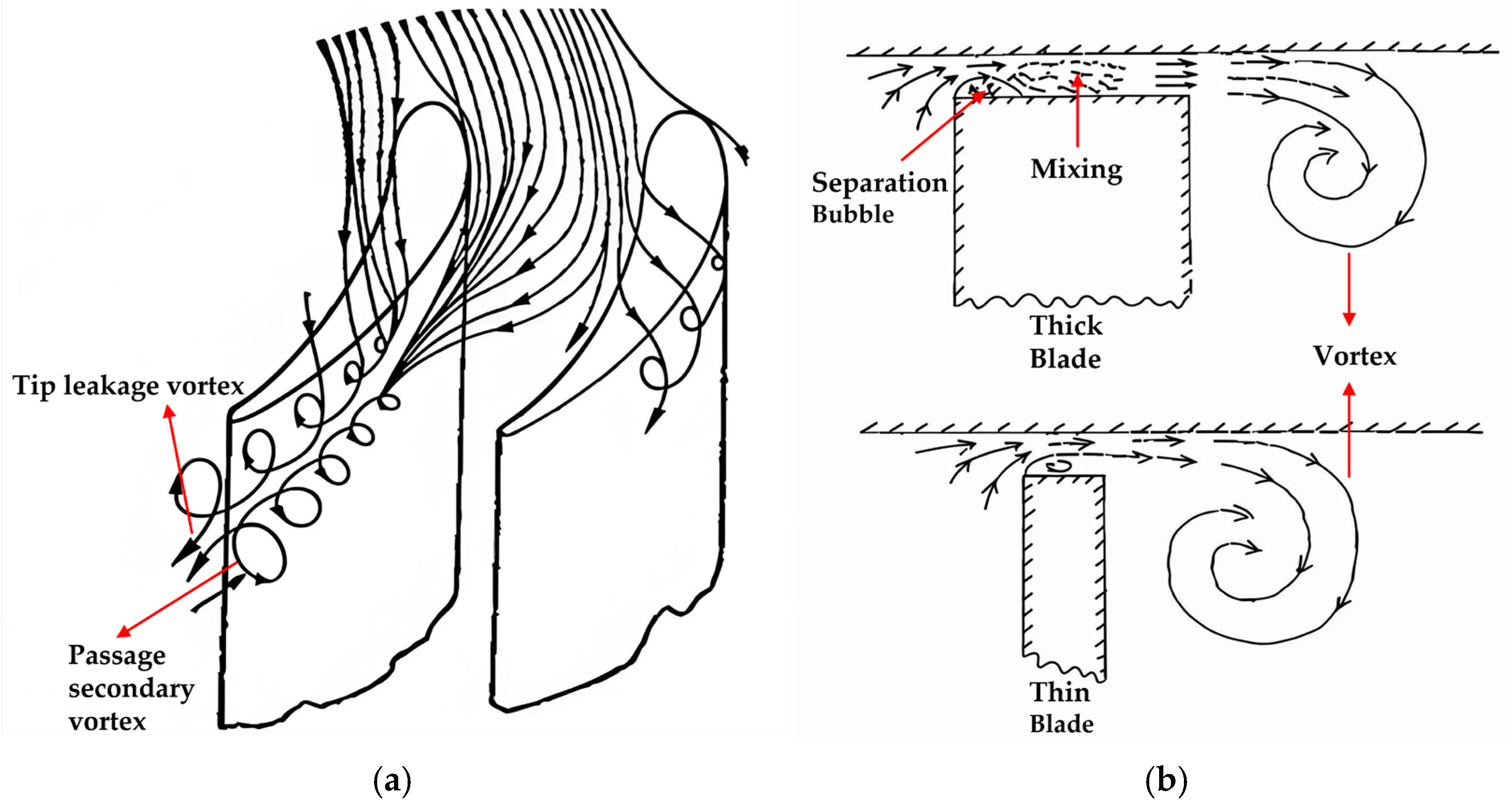


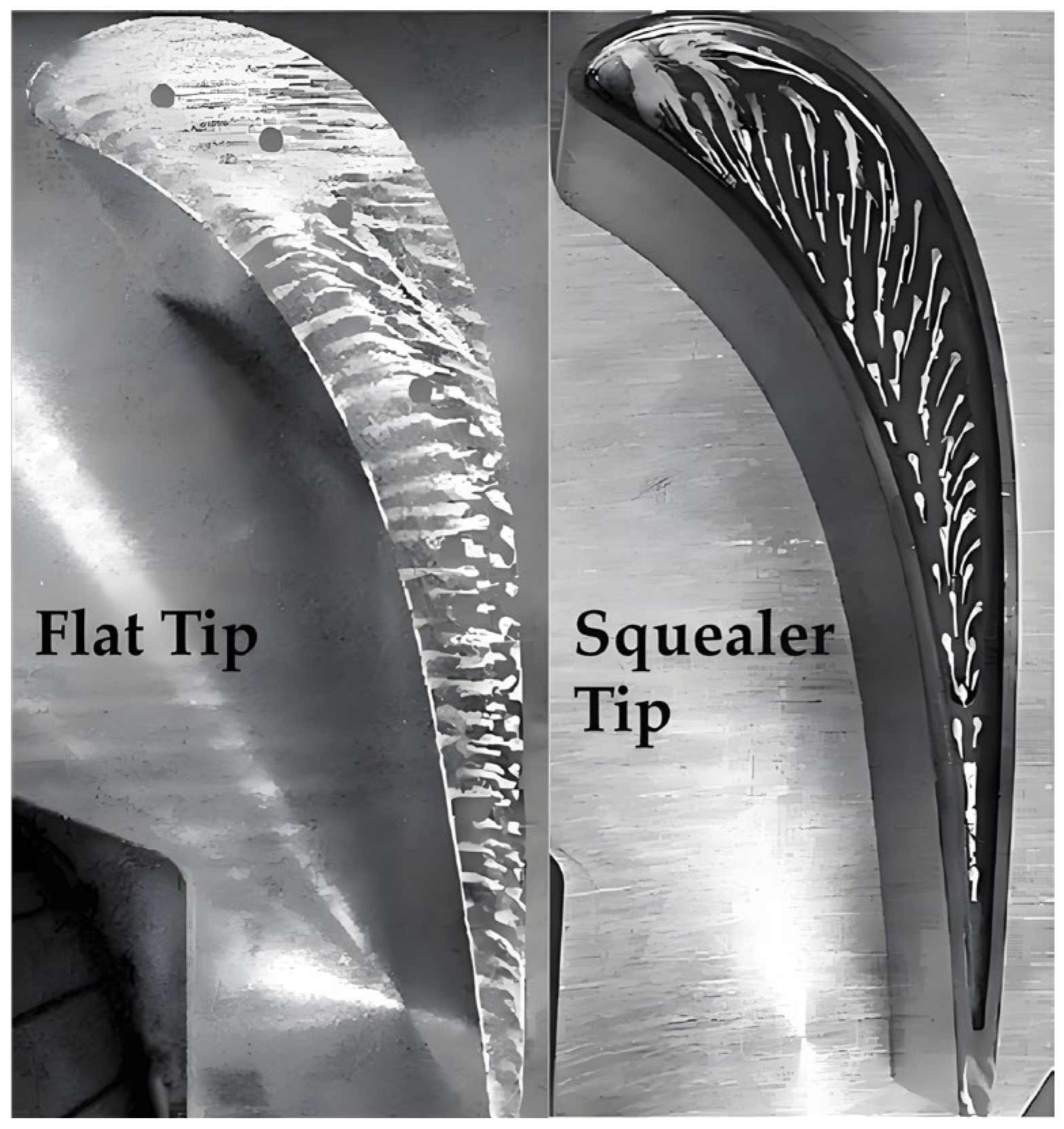





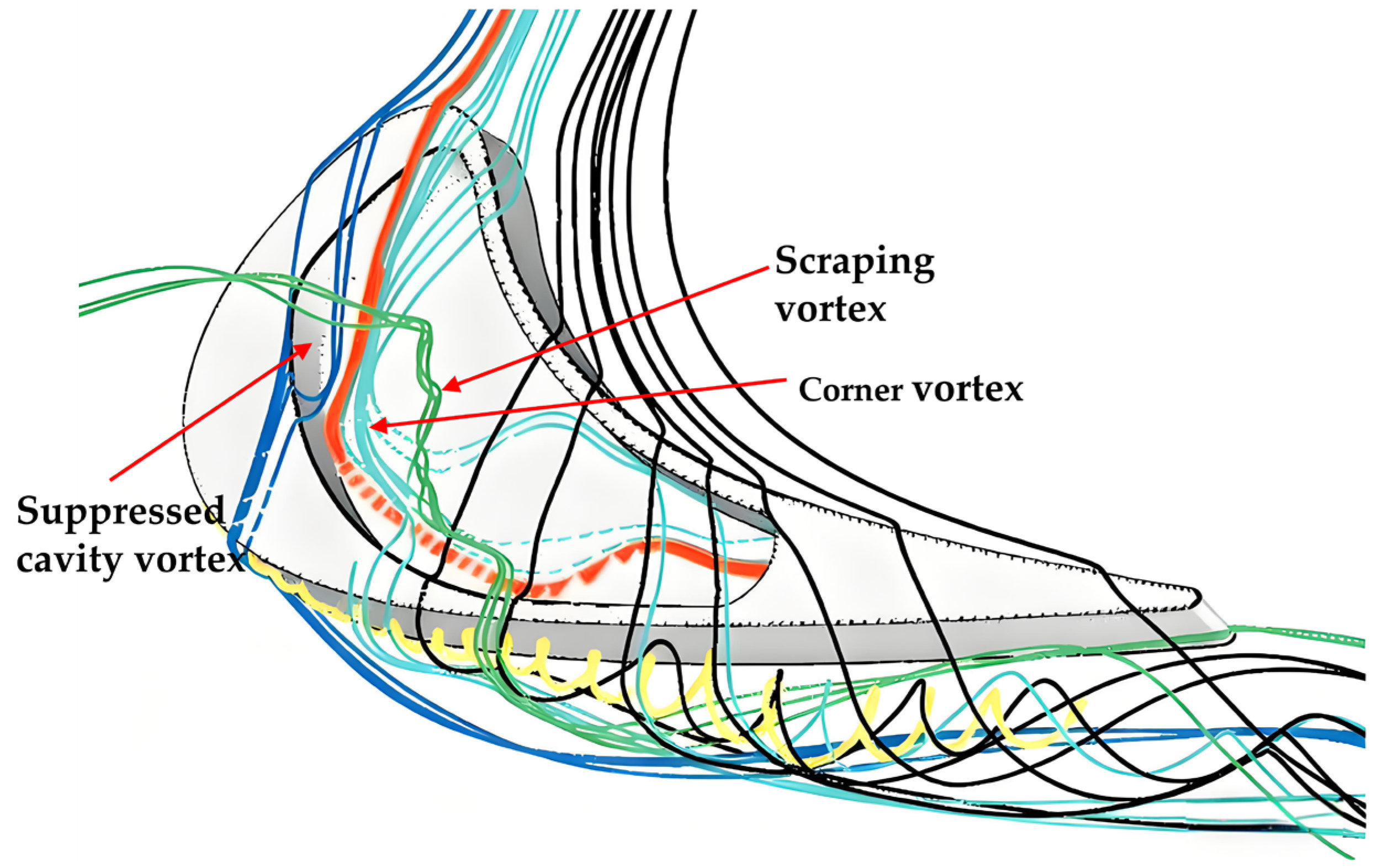

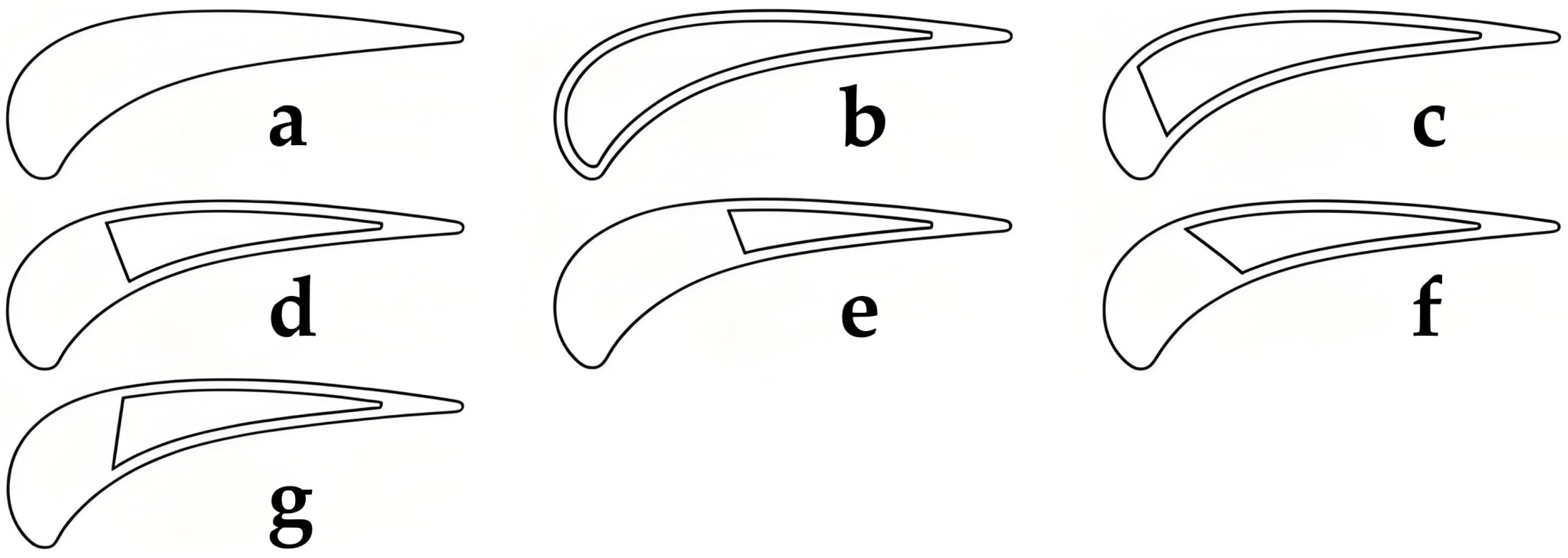



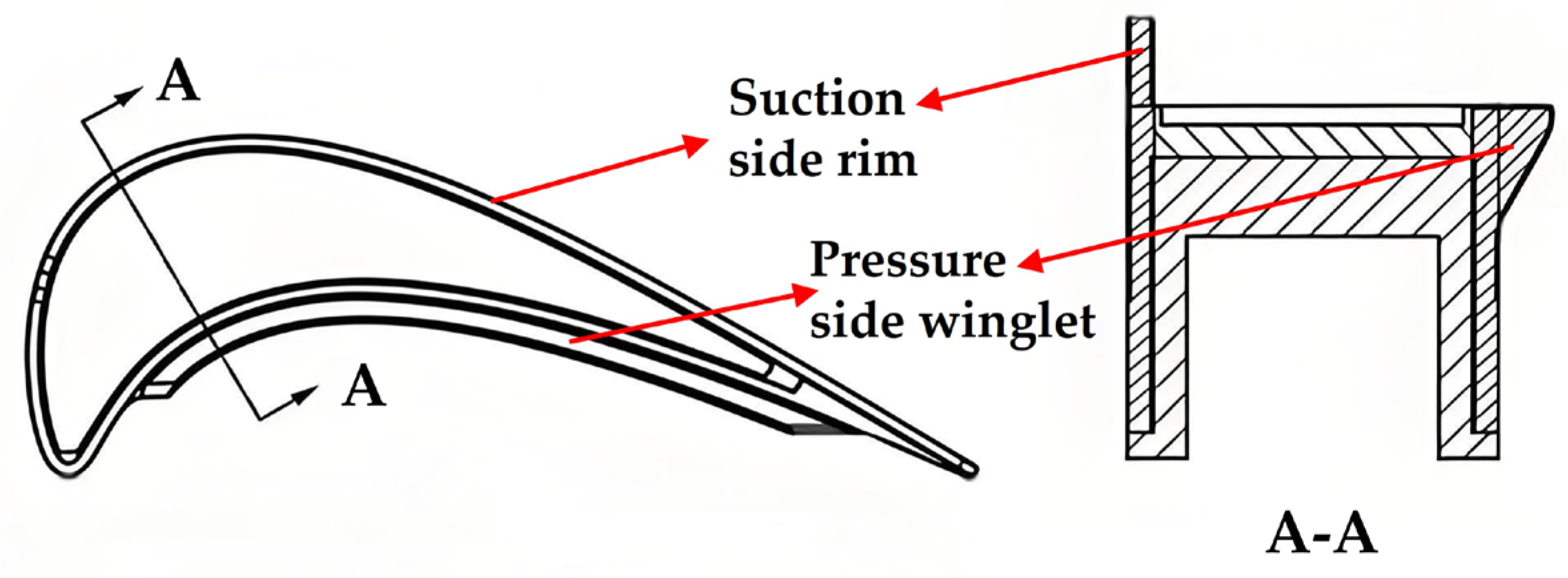
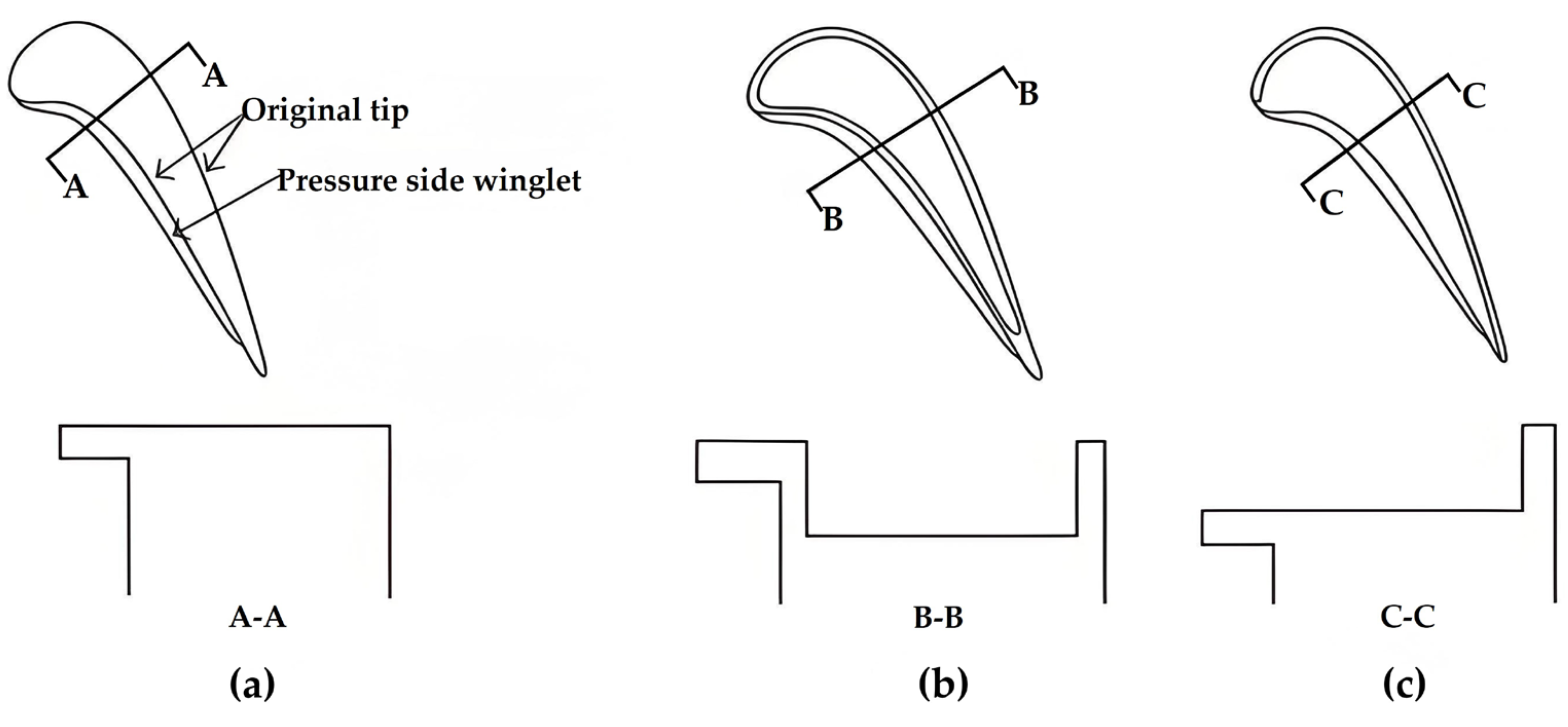
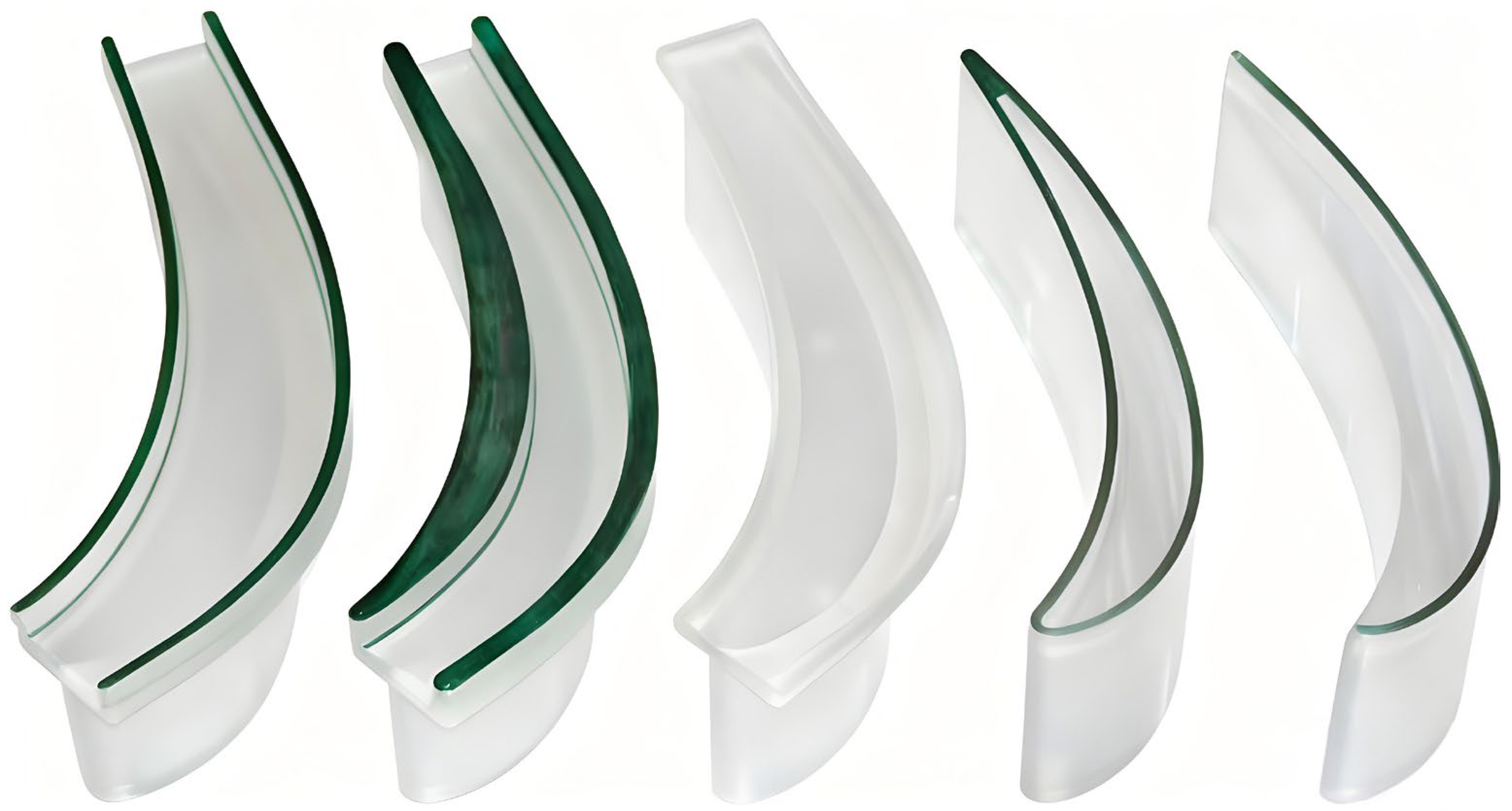


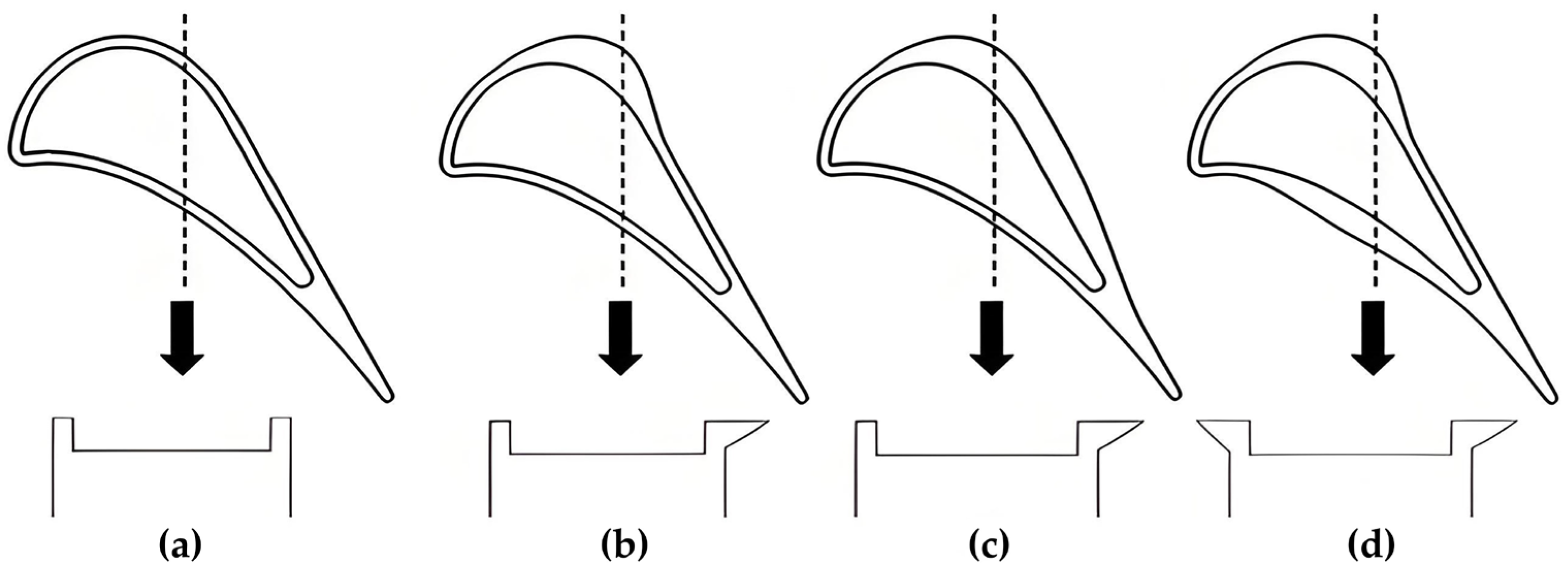
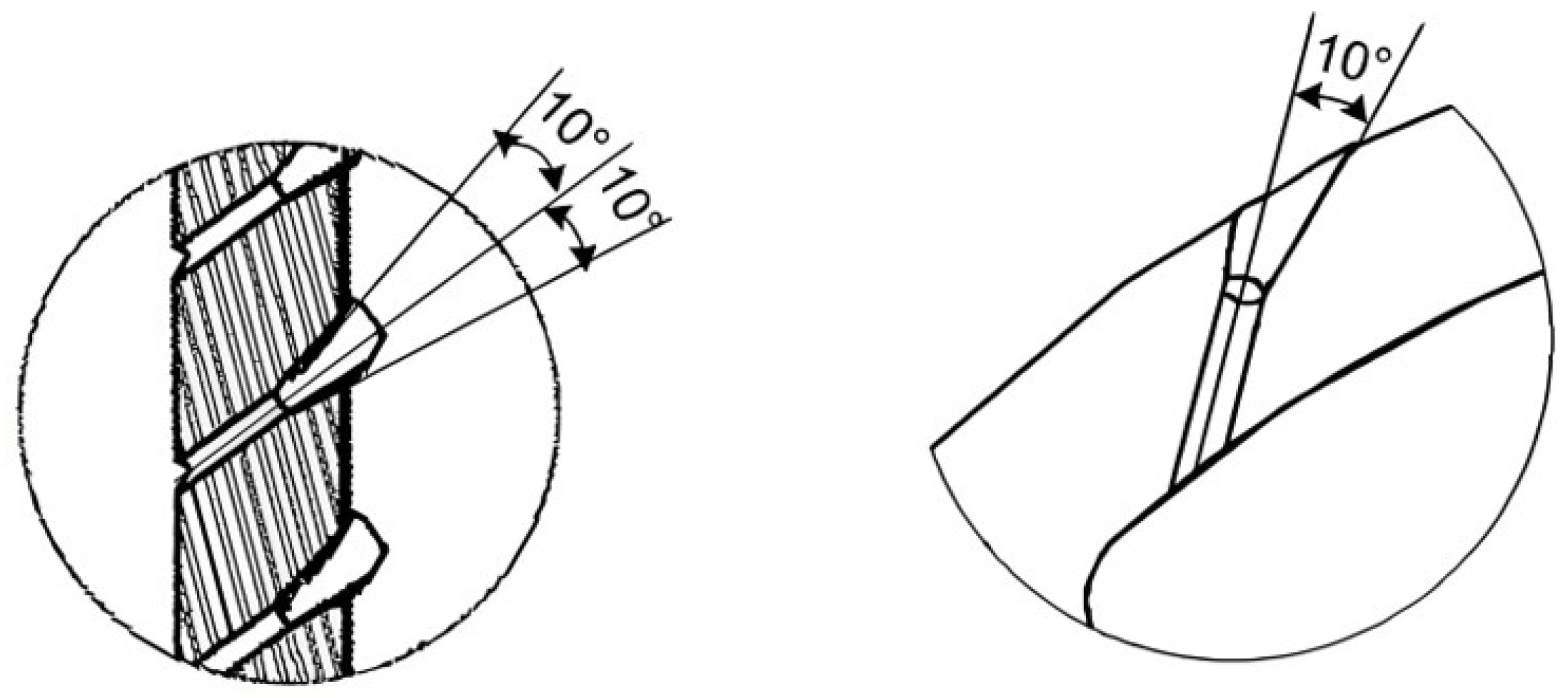
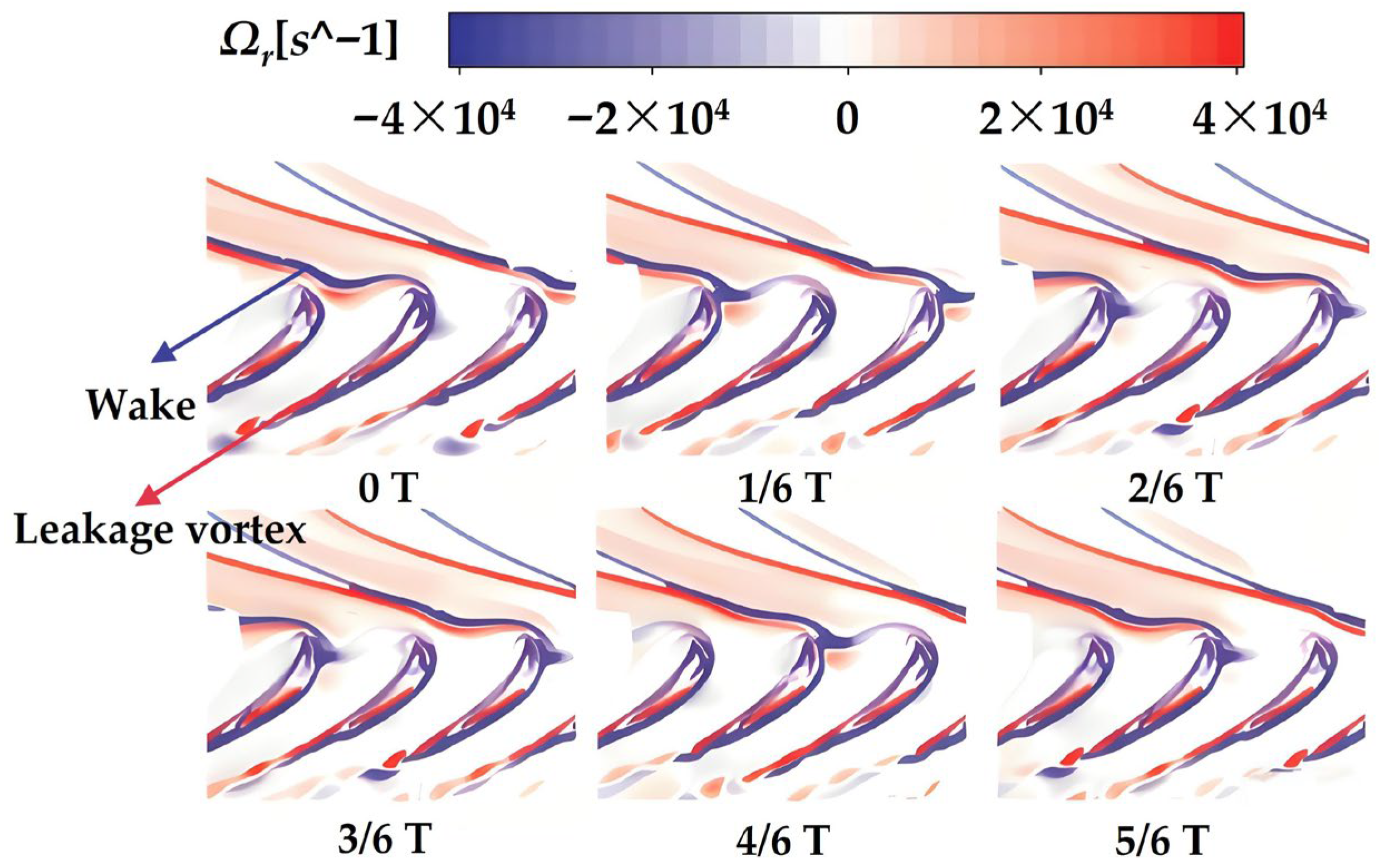
| Tip Configurations | Schematic Diagram | Results |
|---|---|---|
| Conventional squealer tip [4,37,38,39,40] | 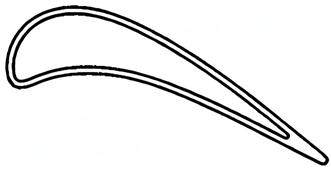 | Lower overall heat transfer coefficient than flat tip. [4,37,38,39,40] High heat transfer region on cavity floor moved toward the suction side and the leading edge compared to flat tip. [38,40] High heat transfer region on squealer rims increased particularly at the trailing edge and the suction side compared to flat tip [4,37,38]. |
| Squealer with different cavity depths [42,43] | Existing an optimum cavity depth for leakage flow reduction. (3% cavity depth-to-blade span ratio 42, 2.75% rim height-to-axial chord length ratio [43]). Depth increased; heat transfer coefficient decreased. | |
| Squealer tip with different rim widths [44,45] | Existing optimum rim width for aerodynamic efficiency (0.58% of axial chord) [44]. Existing optimum rim width for total heat transfer coefficient (0.8% of blade height) [45]. | |
| Squealer tip with cooling holes [47,48,49] | 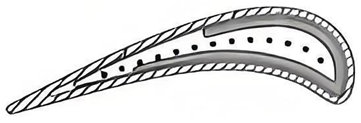 | Higher overall film cooling effectiveness than flat tip [47,48]. Depth increased, leakage flow reduction initially increased and then decreased [49]. Film holes located on the separation line could be beneficial for film cooling effectiveness [49]. |
| Squealer tip with different rim arrangements [53,54] | 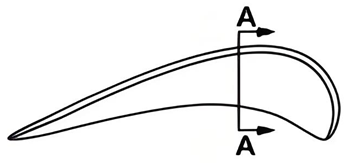 | Flow reattachment downstream from the squealer rim results in a high heat transfer region. Suction-side squealer showed highest reduction in heat transfer coefficient. |
| Squealer tip with nonuniform rim width [36] | 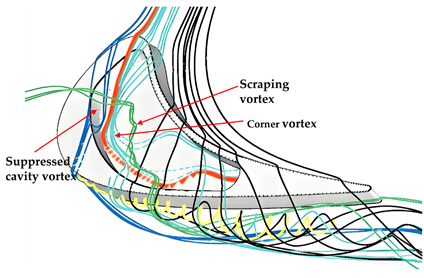 | Optimizing the flow structure compared to conventional squealer tip. Result of 0.38% total efficiency enhancement and 7% Nusselt number reduction. |
| Partial squealer tip [56,57] |  | Suction-side partial squealers showed higher stage efficiency enhancement than pressure side. |
| Partial squealer tip (pressure side trailing edge cut) with cooling holes [58,59,60] |  | Higher film cooling effectiveness in trailing-edge region compared to full squealer tip [58,59]. Lower film cooling effectiveness in the leading-edge region compared to full squealer tip [60]. |
| Partial squealer tips with cooling holes [61] | Suction-side cut back showed better film cooling effectiveness compared to pressure-side cutback. | |
| Partial cavity tips [62] |  | Tip with cavity from 10% chord showed the lowest heat transfer coefficient. Conventional squealer tip showed the highest cooling effectiveness. |
| Partial cavity tips [63] | 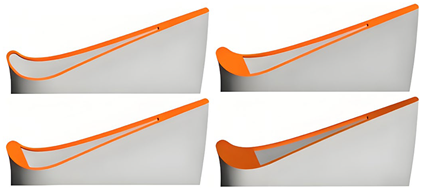 | Filling area increased, heat transfer coefficient initially increased and then decreased. |
| Partial cavity tips with ribs [64] | Suction-side ribbed configuration (SRT) showed 27.4% reduction in the averaged Nusselt number and 16.3% decrease in leakage flow compared to flat tip. Lateral ribs configuration (SLCT) showed 27.2% reduction in averaged Nusselt number and 17.3% decrease in leakage flow compared to flat tip. | |
| Partial squealer design with an island closed rim [65] | 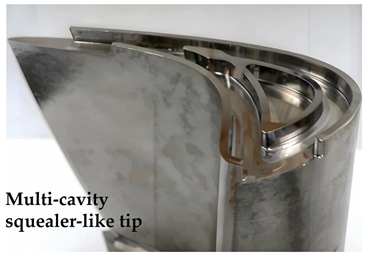 | Lower leakage flow, 3% higher efficiency, and higher heat flux compared to flat tip. |
| Multi-cavity tip [67] | Four-rib configuration showed weakened high heat region by reattachment flow, lower heat transfer, and higher pressure loss compared to conventional squealer tip. Two leading-edge full-ribs and two trailing-edge half-ribs configurations showed the most comprehensive aerothermal performance. | |
| Multi-cavity tip with two ribs at 10% and 25% chord [71] | Result of 24.96% averaged heat transfer coefficient reduction and 18.82% decrease in leakage flow rate compared to conventional uncooled squealer tip. |
| Tip Configurations | Schematic Diagram | Results |
|---|---|---|
| Winglet tip [6,72,73] | 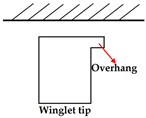 | Result of 7% discharge coefficient reduction compared to flat tip. Result of 5% discrepancy with data from reference [6]. Suction-side winglet tip showed higher leakage reduction compared to suction-side winglet tip [72]. |
| Full-coverage winglet tip [74,75] | High and lower mass/heat transfer at overhang region and original surface, respectively, compared to flat tip. Existing liner negative correlation trend between mass/heat transfer on the winglet bottom and the tip clearance. | |
| Winglet tip with two aerofoils [76] | 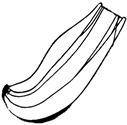 | Result of 1.2–1.8% stage efficiency improvement and 30% tip loss exchange rate reduction compared to flat tip. |
| Winglet tip with two aerofoils [76,77] | 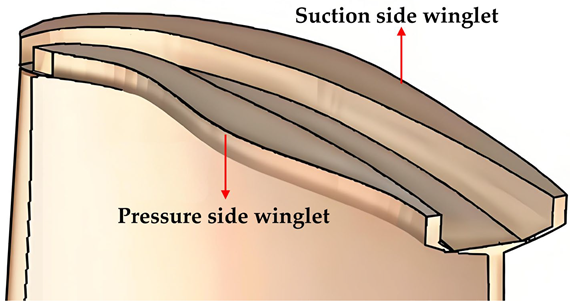 | Equivalent leakage flow loss with a two-fin shrouded tip. |
| Winglet tip with two aerofoils and rectangle groove [78,79,80,81] |  | Showed 2.7 times higher averaged heat load than flat tip [78,79]. Showed 14% decreased Nusselt number with the endwall motion [80,81]. Showed 9% increased film cooling effectiveness with the endwall motion [80,81]. |
| Pressure-side winglet and suction-side squealer [83] | 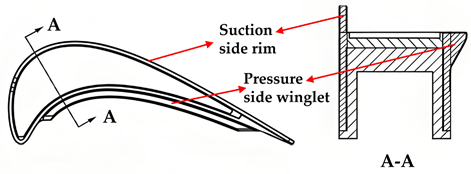 | Lower mass transfer coefficient compared to conventional squealer tip. |
| Pressure-side winglet [84] |  | Result of 7% averaged heat transfer coefficient reduction compared to flat tip. |
| Pressure-side winglet and full squealer [84] | Little reduction in leakage flow and virtually no reduction in heat compared to full squealer tip. | |
| Pressure-side winglet and suction-side squealer [84] | Resulted in 5.5% less heat transfer and 27% lower pressure loss compared to suction side squealer tip. | |
| Full-coverage winglet and full squealer [85,86] | Cavity floor showed lower mass/heat transfer than winglet surface. | |
| Pressure-side winglet and suction-side squealer [87,88] | The 60% winglet showed 13.8% total pressure loss reduction compared with conventional squealer tip [87]. The 80% winglet showed 15.8% heat transfer coefficient reduction compared with conventional squealer tip [88]. Result of 54.2% higher cooling effectiveness than conventional squealer tip at 1.5% tip clearance [88]. | |
| Thin squealer on winglet [89,90] | 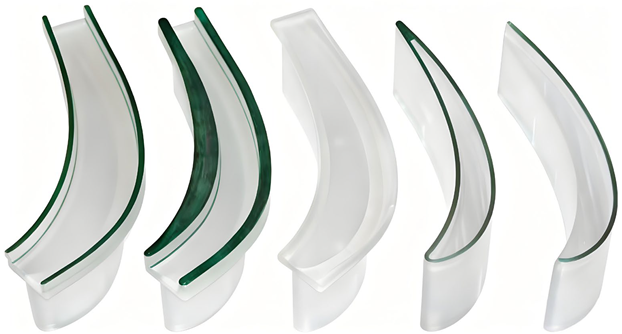 | Result of 19.4–26.6% lower leakage flow rate than flat tip. |
| Multi-cavity squealer tip [91] | Suction-side arrangement performance best in reducing heat transfer, leakage flow, and pressure loss. | |
| Winglet by a novel parameterization method [92] |  | Winglets extending from only the early suction side showed superior performance in improving efficiency. |
| Optimized suction side winglet–squealer tip [93] |  | Result of 18.1% leakage flow loss reduction compared to conventional squealer tip. |
| Optimized winglet–squealer tip [94,95] | 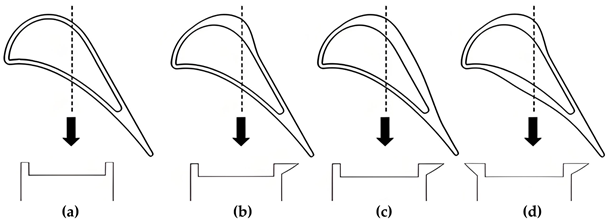 | Small suction-side winglet tip showed the best aerothermal performance. |
Disclaimer/Publisher’s Note: The statements, opinions and data contained in all publications are solely those of the individual author(s) and contributor(s) and not of MDPI and/or the editor(s). MDPI and/or the editor(s) disclaim responsibility for any injury to people or property resulting from any ideas, methods, instructions or products referred to in the content. |
© 2025 by the authors. Licensee MDPI, Basel, Switzerland. This article is an open access article distributed under the terms and conditions of the Creative Commons Attribution (CC BY) license (https://creativecommons.org/licenses/by/4.0/).
Share and Cite
Wu, B.; Ren, L.; Wen, R.; Yang, C.; Zheng, D. Advances in the Aerothermal Performance Enhancement of Turbine Blade Tip Configurations. Energies 2025, 18, 5930. https://doi.org/10.3390/en18225930
Wu B, Ren L, Wen R, Yang C, Zheng D. Advances in the Aerothermal Performance Enhancement of Turbine Blade Tip Configurations. Energies. 2025; 18(22):5930. https://doi.org/10.3390/en18225930
Chicago/Turabian StyleWu, Bin, Lei Ren, Renyi Wen, Chenrui Yang, and Daren Zheng. 2025. "Advances in the Aerothermal Performance Enhancement of Turbine Blade Tip Configurations" Energies 18, no. 22: 5930. https://doi.org/10.3390/en18225930
APA StyleWu, B., Ren, L., Wen, R., Yang, C., & Zheng, D. (2025). Advances in the Aerothermal Performance Enhancement of Turbine Blade Tip Configurations. Energies, 18(22), 5930. https://doi.org/10.3390/en18225930





